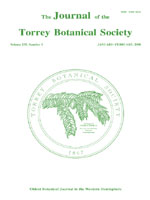Populations of wide-ranging plant species may vary significantly from one another with respect to physiological and reproductive traits, allowing each population to adapt to its local environment. One example of this variation is observed as differences in floral form and breeding system. In the California wildflower Clarkia tembloriensis Vasek, breeding system varies from populations of outcross-pollinating individuals, with relatively large, protandrous flowers, to populations of self-pollinating individuals, with small, nonprotandrous flowers. Variation within the selfing flower types includes populations with small flowers that are polymorphic for petal form; WT (flowers with normal expanded petals) and crinkle-petal (cp; flowers with small, unexpanded petals). The aims of this study were to investigate the nature of this variation in floral biology with respect to resource allocation to male and female function and to components important for reproductive success in the six California populations included in this study. Our study revealed that more resources were allocated to pollen production relative to ovule production in large, outcrossing flowers than in small, selfing flowers. Pollen deposition on the stigma was significantly higher in selfing flowers than it was in outcrossing flowers and significantly higher in cp selfing flowers than it was in WT selfing flowers. Despite these differences, sufficient pollen was deposited on stigmas in all populations to fertilize available ovules. The numbers of seeds produced per capsule was significantly lower in populations of C. tembloriensis, with small, selfing flowers than it was in large, outcrossing flowers, which was probably due to differences in rainfall amounts between populations. Large outcrossers occupy the core of the species range, whereas small selfers occupy marginal habitat. The differences we observed reflect adaptations of each population to their local environment.
How to translate text using browser tools
6 August 2015
Floral biology and the evolution of selfing in natural populations of Clarkia tembloriensis Vasek (Onagraceae)
Nancy L. Smith-Huerta,
Alfredo J. Huerta
ACCESS THE FULL ARTICLE
evolution of selfing
Floral biology
resource allocation





